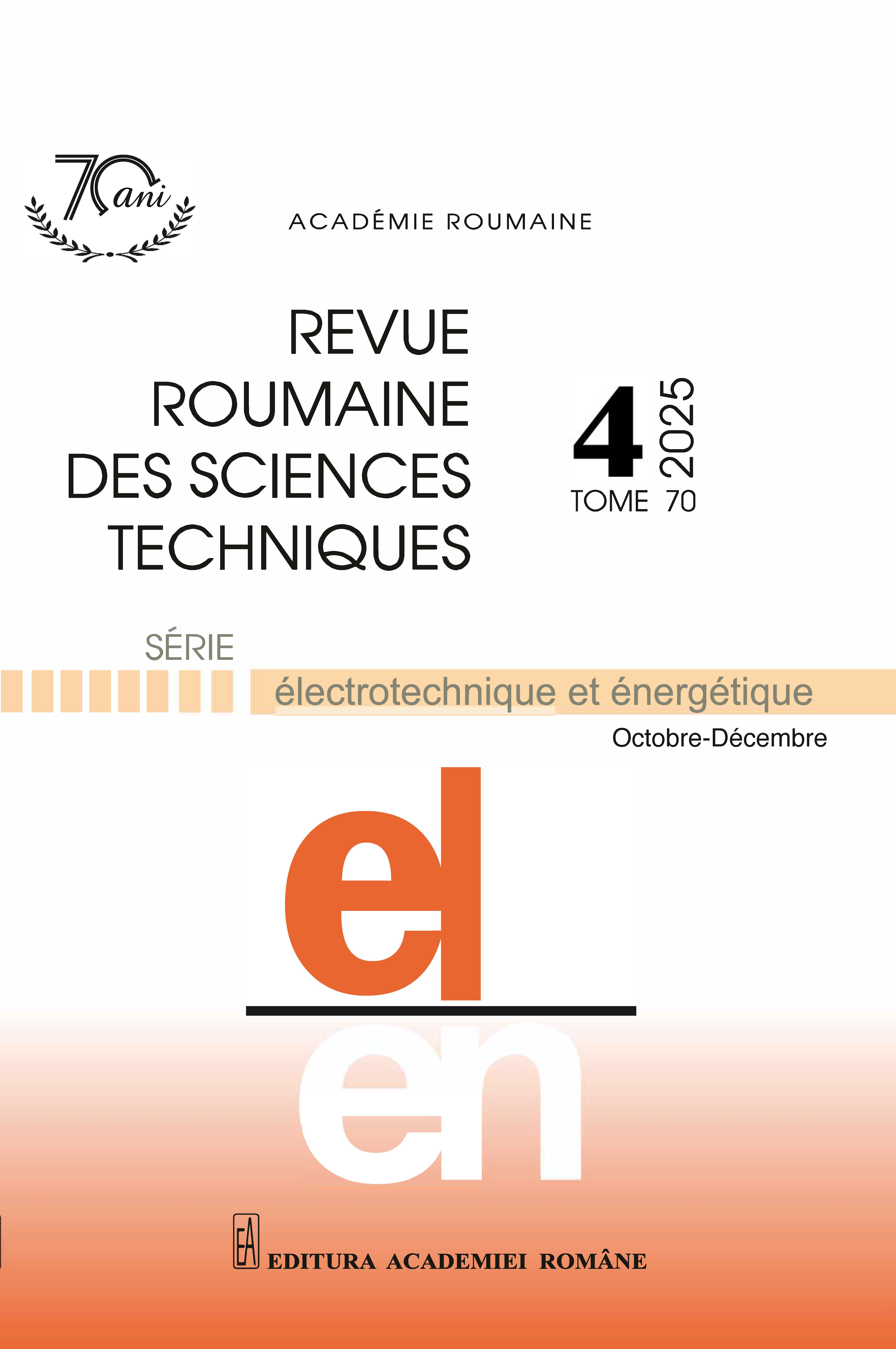HARMONIC ANALYSIS OF DISTRIBUTED ENERGY SOURCES USING SLIDING FFT AND IEC 61000-4-7
DOI:
https://doi.org/10.59277/RRST-EE.2025.4.13Keywords:
EN 50160, Fast Fourier transform (FFT); , Harmonics, Hydro power plant, IEEE 519, Photovoltaic (PV) power plantAbstract
This paper presents the results of harmonic analysis of the current and voltage signals measured in the points of common coupling (PCC) to the distribution networks of several distributed energy sources. One small hydro (HPP) and four small photovoltaic (PV) power plants are considered. Voltage and current harmonics are calculated in two ways: 1) as per standard IEC 61000-4-7, and in accordance with IEEE 519 and EN 50160, and 2) by sliding fast Fourier transform (SFFT), which is applied to calculate time-varying current and voltage harmonics in the specific recorded signals. Application of IEEE 519 and EN 50160 yields different results and conclusions due to different calculation procedures and limiting values. PV power plants can generate almost sinusoidal currents when operating with high power, while the HPP can generate currents with strongly distorted waveshapes when supplying large nonlinear loads. As a result, all four PV power plants meet the requirements for current and voltage harmonics, whereas the analyzed HPP does not meet some of the defined limits. The SFFT analysis confirms the feasibility of dynamic real-time harmonic monitoring, which can play a crucial role in modern distribution networks.
References
(1) V.G. Dogaru, F.D. Dogaru, V. Navrapescu, and L.M. Constantinescu, From the photovoltaic effect to a low voltage photovoltaic grid challenge–a review, Rev. Roum. Sci. Techn. – Électrotechn. et Énerg., 69, 3, pp. 263–268 (2024).
(2) R. Elumalai, Maximum power quality tracking of artificial neural network controller-based double-fed induction generator for wind energy conversion system, Rev. Roum. Sci. Techn. – Électrotechn. et Énerg., 69, 2, pp. 189–194 (2024).
(3) M. Milovanović, J. Radosavljević, B. Perović, J. Vukašinović, A. Jovanović, and M. Banjanin, Point-estimate method for probabilistic power flow in unbalanced and distorted distribution systems, In IEEE 23rd International Symposium Infoteh-Jahorina (INFOTEH), pp. 1–6 (2024).
(4) ***Study Committee C4, Work Group C4.112, Guidelines for power quality monitoring– measurement locations, processing and presentation of data, CIGRE/CIRED Technical brochures 596 (2014).
(5) ***Voltage characteristics of electricity supplied by public electricity networks, EN 50160:2010 (2010).
(6) ***IEEE Standard for Harmonic Control in Electric Power Systems, IEEE Std 519-2022 (2022).
(7) Carretero-Hernandez, E. Artigao, S. Martin-Martinez, C. Alvarez-Ortega, M. Ochoa-Gimenez, and E. Gomez-Lazaro, Comparison of harmonic emission in LV side of a large grid-connected PV power plant, Electric Power Systems Research, 223, 109586 (2023).
(8) R.K. Varma, S.A. Rahman, T. Vanderheide, and M.D.N. Dang, Harmonic impact of a 20-MW PV solar farm on a utility distribution network, IEEE Power and Energy Technology Systems Journal, 3, 3, pp. 89–98 (2016).
(9) M. Ikić and J. Mikulović, Experimental evaluation of distortion effect for grid-connected PV systems concerning different types of electric power quantities, Energies, 15, 2, 416 (2022).
(10) E. Melić, A. Bosović, and M. Musić, Analysis of the impact of different distributed generator technologies on harmonic voltages, Rev. Roum. Sci. Techn. – Électrotechn. et Énerg., 68, 2, pp. 146–151 (2023).
(11) L.F. Pak, V. Dinavahi, G. Chang, M. Steurer, and P.F. Ribeiro, Real-Time Digital time-varying harmonic modeling and simulation techniques, IEEE task force on harmonics modeling and simulation, IEEE Transactions on Power Delivery, 22, 2, pp. 1218–1227 (2007).
(12) M. Banjanin and M. Ikić, Measurement and analysis of the electric power quality parameters at the point of connection of PV plant Brankovići 1 and PV plant Brankovići 3 to the electrical distribution network, 22nd International Symposium INFOTEH-JAHORINA, pp. 197–202 (2023).
(13) M. Banjanin, M. Ikić, M. Timotija, S. Makljenović, and L. Gluhović, Measurement and analysis of the electric power quality parameters at the point of connection of MHE Miljacka to the 10 kV electrical distribution network, 22nd International Symposium INFOTEH-JAHORINA, pp. 191–196 (2023).
(14) ***Electromagnetic compatibility (EMC) – Part 4-7: Testing and measurement techniques – General guide on harmonics and interharmonics measurements and instrumentation, for power supply systems and equipment connected thereto, IEC 61000-4-7:2002+AMD1:2008 CSV, Edition 2.1 (2009).
(15) ***PQA, Metrel (2024).
(16) M. Banjanin, M. Milovanović, and J. Radosavljević, Voltage dips and swells detection by sliding fast Fourier transform: Possibilities for application in modern distribution networks, Journal of Electrical Engineering, 76, 1, pp. 58–71 (2025).
Downloads
Published
Issue
Section
License
Copyright (c) 2025 REVUE ROUMAINE DES SCIENCES TECHNIQUES — SÉRIE ÉLECTROTECHNIQUE ET ÉNERGÉTIQUE

This work is licensed under a Creative Commons Attribution-NonCommercial-NoDerivatives 4.0 International License.


